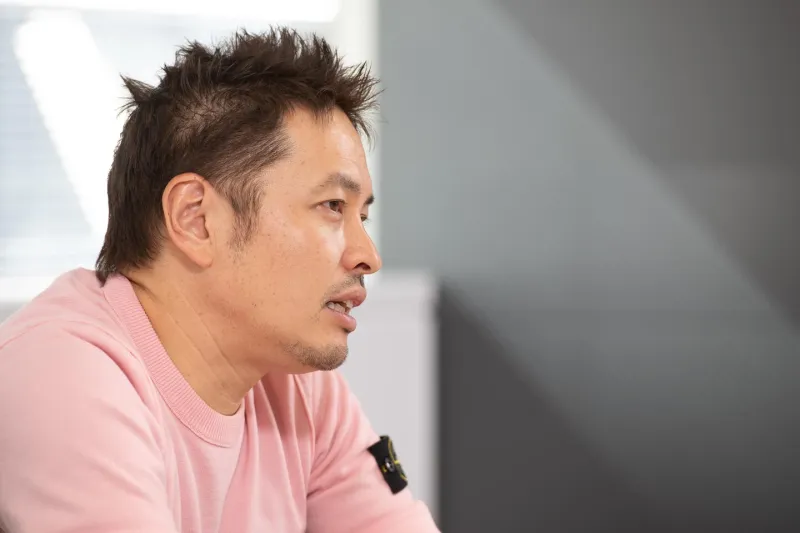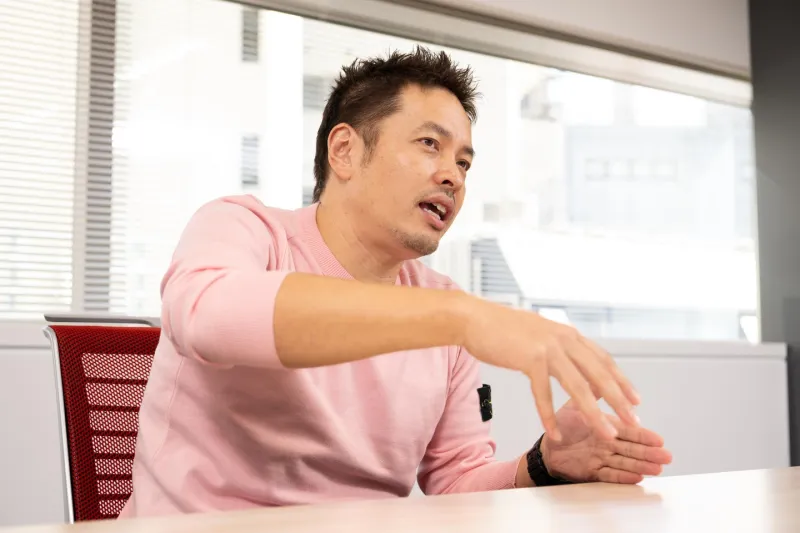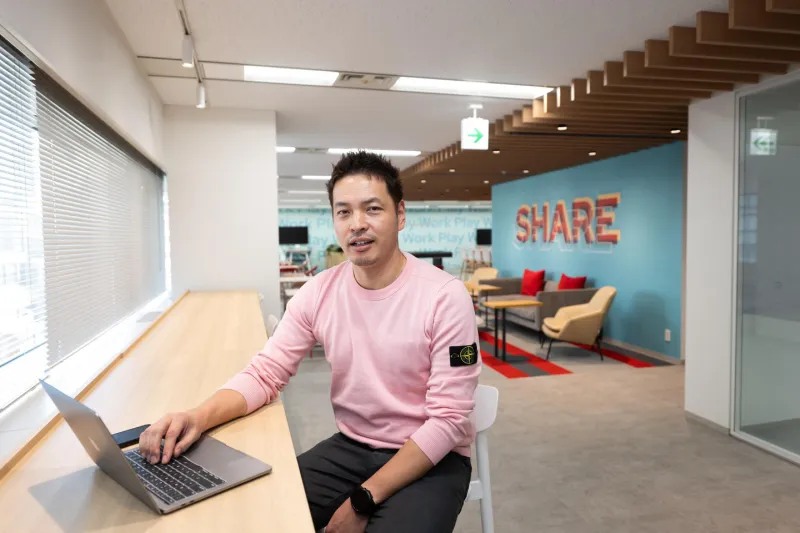
In 2018, Red Hat launched our Open Innovation Labs in Japan. Through this program, our consulting team works directly with clients' development teams, offering hands-on guidance in modern methodologies such as agile development and DevOps.
We recently interviewed Yoshikazu Y., agile engagement lead and the head of Open Innovation Labs in Japan. Yoshikazu shared insights on the purpose of Open Innovation Labs, the appeal of working as an engagement lead, the ideal candidates their team is looking for, and current opportunities on the team.

Red Hat: Tell us about your career history.
Yoshikazu: I initially worked at SIer, where I gained experience in different areas such as web systems, legacy core systems, databases, and infrastructure development and construction. During that time, I had several opportunities to collaborate with Red Hat on open source community projects, eventually leading to my joining the company. Initially, I worked as a technical consultant for the middleware product lines, and around 2015, I launched Red Hat's DevOps consulting services. Later, in 2018, I established the Japanese version of Open Innovation Labs, following the example set by our U.S. counterparts.
I joined Red Hat because it was a rare company that had successfully built a business around open source. I had an instinctive feeling that working here would be exciting. Another aspect that attracted me was the open culture. For instance, I once sat at a dinner at a Red Hat event next to Jim Whitehurst, former president and CEO of Red Hat. Even as a newly hired employee, I could converse with Jim and share my thoughts casually. Offering frank and honest opinions didn't affect one's evaluations or career in any negative way. I was surprised by this level of openness when I first joined.
Red Hat: What kind of service does Open Innovation Labs offer in Japan?
Yoshikazu: Open Innovation Labs originally started as a service in the U.S. Initially, it was designed to promote innovative product development, but in Japan, it has uniquely evolved into a service that supports "high-agility business operations."
So, what does "high agility" mean? It refers to a state where, when a business idea emerges, it can be tested or released in the market as quickly as possible with the smallest possible investment. It also means being able to repeat this process over and over again.
To achieve this, several key capabilities are required: the ability to generate ideas, the skill to identify and extract the core elements of those ideas, the ability to assess whether there is market demand, the capacity to make swift, cross-organizational decisions, and strong software development skills. Open Innovation Labs aims to help clients develop these abilities and grow their businesses. We also believe that one of the most important methodologies for enhancing agility is agile development.
The engagement lead is essential to agile culture
Red Hat: What role does the engagement lead play within Open Innovation Labs?
Yoshikazu: An agile team is formed with members from various client departments and Red Hat to promote agile transformation for the client. The engagement lead’s fundamental role is to ensure that this team functions as a self-sufficient unit by providing teaching, coaching, and mentoring.
However, the Red Hat engagement lead is also responsible for negotiating and coordinating between various departments. This is necessary because an agile team is a small-scale group responsible for everything from idea generation to release, and consists of members from different teams — like engineers, designers, marketers and data analysts. Just forming the team doesn’t instantly make it agile.
For instance, each member’s performance evaluation criteria are still tied to their original departments, such as design or engineering. To unite the team under one goal and maximize its performance, the engagement lead negotiates and coordinates with the heads of these departments. In traditional Japanese companies, where organizational structures are often still quite formal, the engagement lead must particularly focus on these negotiation tasks. Engaging with various departments requires knowledge of business concepts like ROI and LTV, in addition to design and engineering expertise.
Red Hat: It seems that the scope of work is quite extensive?
Yoshikazu: Yes, and I believe that's one of the key points that sets us apart from our competitors. If the engagement lead were to only offer advice based on frameworks and leave the business side entirely to the business team, it would be difficult to make the team truly agile. When you’re committed to achieving results, such as increasing the client’s profits, the engagement lead naturally has to be capable of handling all aspects of the process.

Red Hat: It seems that the attention on engagement leads in Japan has been growing each year. What do you think is driving this trend?
Yoshikazu: The rising interest in agile and in the engagement lead role in Japan has only emerged in the past one to two years. About three to four years ago, many companies said, "We've vaguely heard of agile, but we don't see the need to act on it ourselves."
One of the reasons Japanese companies have started recognizing its importance is the generational shift in leadership. Leaders who are now shouldering the future of their companies have begun to realize that the market is moving extremely fast and unpredictably - that there’s a real risk of falling behind without accelerating development speeds, and that waterfall development poses significant risks. With these concerns, they began to change their organizational structures. However, agile is largely just a set of principles and is quite abstract. If companies try to implement it on their own, they often fail. That's when many began thinking, "Let's turn to Red Hat for help."
Red Hat: What are the barriers to agile adoption for Japanese companies?
The main obstacles are organizational structures, culture and mindsets. Traditionally, Japanese companies have operated by creating large, detailed plans to avoid failure before releasing a product or service. In contrast, the agile approach is to make incremental plans and adjust along the way, which allows more opportunity for course correction.
This mindset is a complete 180-degree shift. Failure is inevitable if companies try to transition to agile development while maintaining their traditional organizational structures and mindsets. For example, in the traditional waterfall development model, approval from department heads is required for almost everything, making it impossible for teams on the ground to act independently. However, speed is key in agile development, so a certain level of decision-making power is granted to those on the front lines. The approaches in waterfall and agile development are entirely different.
That's why, once we've identified the departments needed for an agile team and those that need to collaborate, we conduct workshops for the department heads to explain what agile development is, why transitioning to agile is necessary, and what is required for it. Essentially, we communicate that without their agreement and collaboration, the shift to agile won’t happen.
After that, we continuously gather quantitative and qualitative data, and if any issues arise, we report the causes and their impact. This gradual process helps to steer the organization towards an agile structure slowly. Industries like manufacturing and banking, which have a strong affinity for waterfall methodologies, will likely take longer to adapt. However, there have been promising signs of change. For example, some transportation and mobility companies are forming agile teams with as many as 400 to 500 members, showing that the times are shifting.

Reforming legacy systems across Japan
Red Hat: Operating with the principles of freedom, courage, commitment and accountability leads to solutions that might challenge the norms. Do you experience this in your daily work?
Yoshikazu: I experience it almost every day. For example, we may judge that a design document the client deems essential is unnecessary, or we might challenge a multilayered approval process. Sometimes, it can be uncomfortable to be challenged in this way, but if our recommendations ultimately benefit the client, we don't hesitate to make them and help them manage the change.
Fear or anxiety about large-scale changes is a common reason for resistance or pushback. When opinions clash, we revisit the proposed changes, address their concerns, suggest, "Let's try it once, and if it doesn’t work, we can go back." This allows our clients to experience the transformation firsthand. By repeating this process, clients come to gradually understand the benefits and importance of change. It's a slow, deliberate approach, but we couldn't deliver results without it. Our work requires a strong sense of mission, and facing the client with that mindset is crucial.
Red Hat: What are the future prospects and vision for Open Innovation Labs?
Yoshikazu: Our current goal is to make legacy systems agile. Many systems that support major functions in Japan still run on code written 20 years ago. With these massive systems, numerous related departments and personnel make it challenging and time-consuming to implement agile practices. Some areas have been untouched until now, but we plan to tackle them in earnest starting in 2025.
Another goal for the upcoming year is integrating data science and machine learning into the agile framework. Specifically, we aim to incorporate ChatOps into Open Innovation Labs to streamline real-time collaboration and decision-making.
Growth mindset over professional background

Red Hat: What backgrounds do people who thrive at Open Innovation Labs have?
Yoshikazu: The team members come from various backgrounds. We have engineers who have worked in manufacturing, strategy consultants with MBAs and even individuals who are well-known in the Scrum community—there's a broad range of talent.
When hiring for Open Innovation Labs, we focus more on mindset than background. While we check for basic skills, like whether someone can write code, we also assess whether they have a growth mindset. This includes traits like strong curiosity, the ability to take initiative, and whether they can acknowledge mistakes and articulate them clearly.
Red Hat: Could you tell us about any initiatives or support systems in place to encourage employee growth?
Yoshikazu: We frequently conduct 1-on-1 meetings to set and review short-term, medium-term and long-term goals. In these sessions, we clarify goals that the individual and entire team agree on. If there is a gap in achieving these goals, we provide support to help bridge that gap without hesitation. Additionally, Red Hat offers generous support for things like professional certifications and exam fees.
Red Hat: Lastly, could you share what you find most appealing about Red Hat?
Yoshikazu: There are three key points. First, while we've driven and created many agile projects at Red Hat, there's a deeply ingrained understanding that what we're doing is not the entirety of the solution. We are always hungry for new opinions and ideas, so it's an ideal place for people with innovative thoughts and concepts. I like to tell people, at Red Hat, you can take on new challenges immediately.
Secondly, when it comes to software development, Red Hat boasts many highly skilled individuals with diverse expertise. In terms of an environment for growth, I think Red Hat is one of the best workplaces in Japan.
Lastly, the mission of changing Japan's leading companies is significant. There aren’t many opportunities to fundamentally change the organizational structures, cultures and practices of major corporations with your own hands. For those who want to take on such a grand mission and who have the drive to do so, I highly encourage you to join us.
Red Hat Services in Japan is always looking for new team members to work alongside them - check out their open opportunities here.
This article originally appeared on the Wantedly blog.
저자 소개
Red Hat is the world’s leading provider of enterprise open source software solutions, using a community-powered approach to deliver reliable and high-performing Linux, hybrid cloud, container, and Kubernetes technologies.
Red Hat helps customers integrate new and existing IT applications, develop cloud-native applications, standardize on our industry-leading operating system, and automate, secure, and manage complex environments. Award-winning support, training, and consulting services make Red Hat a trusted adviser to the Fortune 500. As a strategic partner to cloud providers, system integrators, application vendors, customers, and open source communities, Red Hat can help organizations prepare for the digital future.
유사한 검색 결과
Behind the scenes of RHEL 10, part 3
How Discover cut $1.4 million from its annual AWS budget in two game days
Why Should You Write Technical Documentation? | Compiler
What’s The Recipe For Burnout? | Compiler
채널별 검색
오토메이션
기술, 팀, 인프라를 위한 IT 자동화 최신 동향
인공지능
고객이 어디서나 AI 워크로드를 실행할 수 있도록 지원하는 플랫폼 업데이트
오픈 하이브리드 클라우드
하이브리드 클라우드로 더욱 유연한 미래를 구축하는 방법을 알아보세요
보안
환경과 기술 전반에 걸쳐 리스크를 감소하는 방법에 대한 최신 정보
엣지 컴퓨팅
엣지에서의 운영을 단순화하는 플랫폼 업데이트
인프라
세계적으로 인정받은 기업용 Linux 플랫폼에 대한 최신 정보
애플리케이션
복잡한 애플리케이션에 대한 솔루션 더 보기
가상화
온프레미스와 클라우드 환경에서 워크로드를 유연하게 운영하기 위한 엔터프라이즈 가상화의 미래
